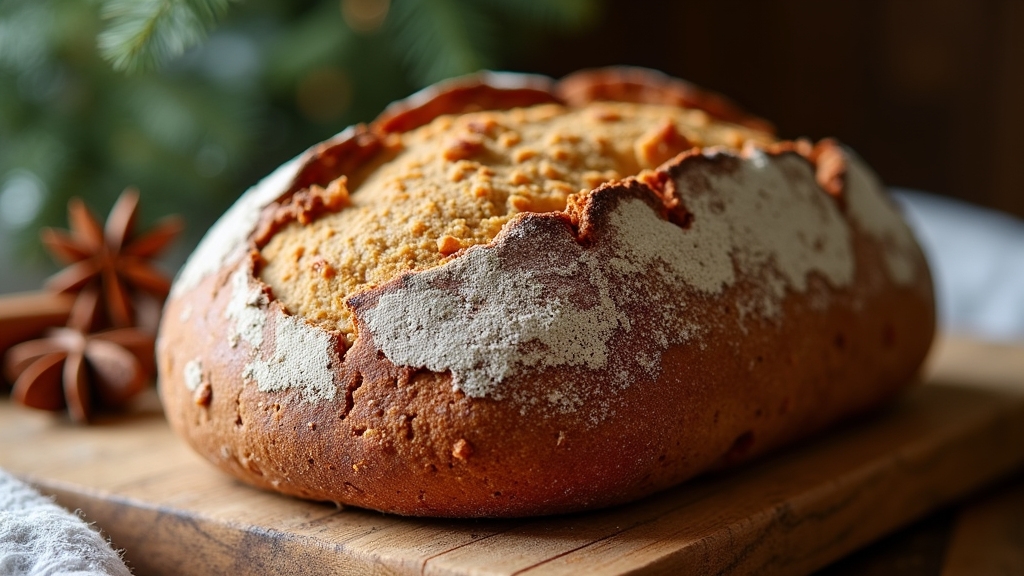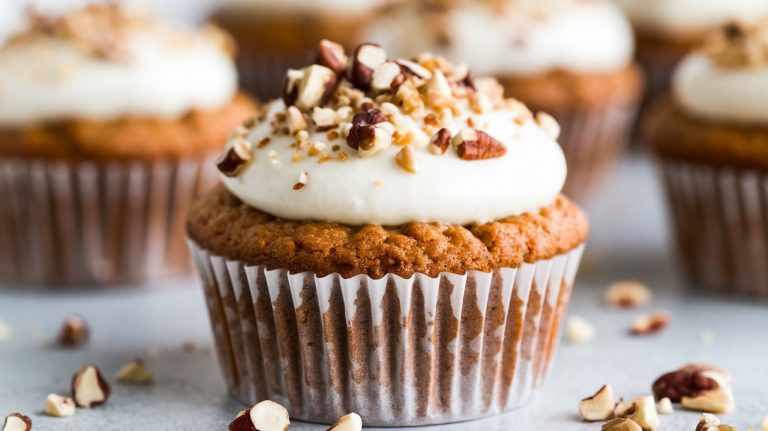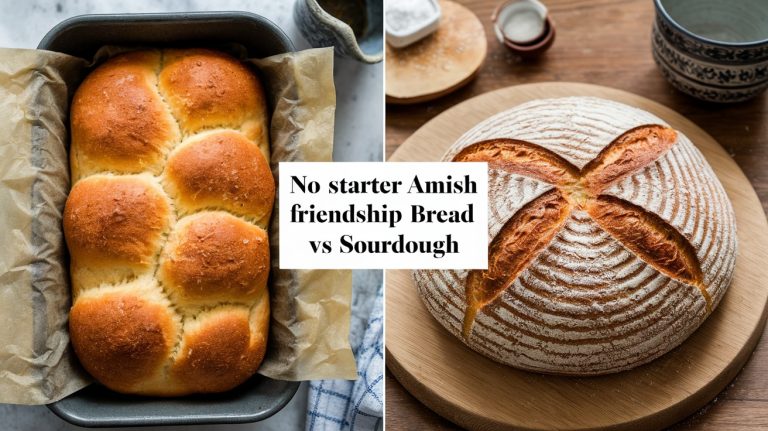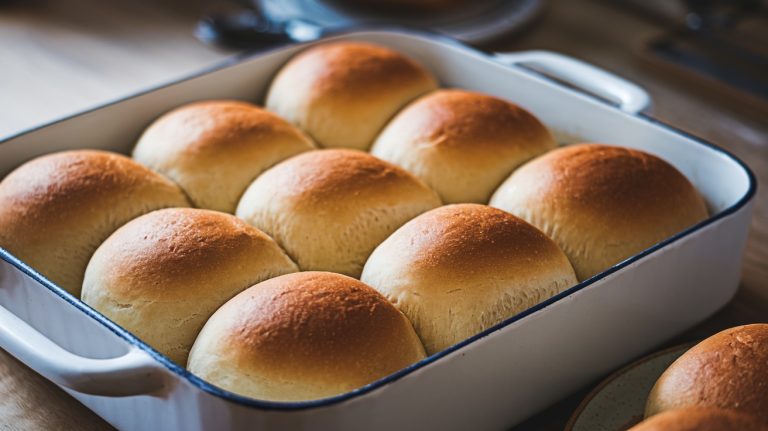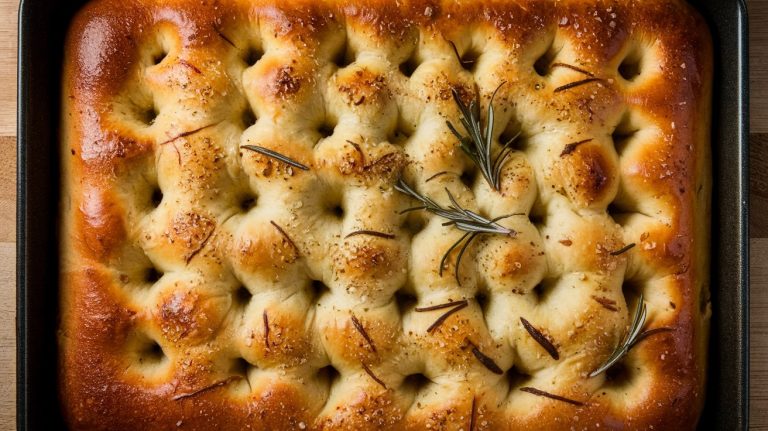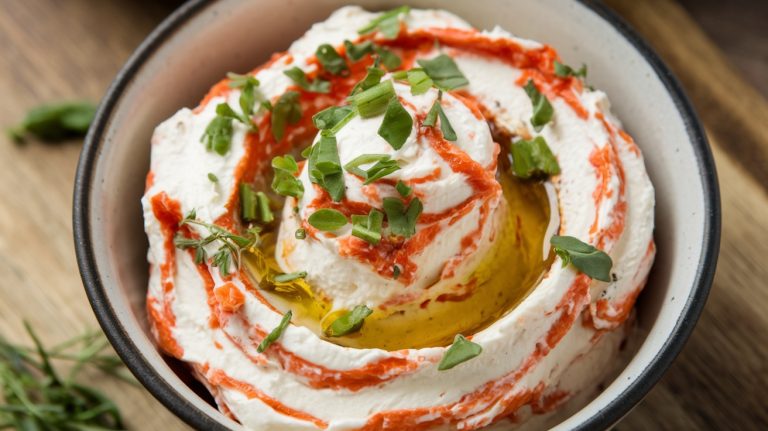Gingerbread Sourdough Bread: A Cozy Holiday Loaf
To bake gingerbread sourdough bread, start with a lively sourdough starter and blend it with bread flour, warm spices like ginger and cinnamon, molasses, and brown sugar for rich flavor.
Mix gently after an autolyse to develop gluten, then ferment at controlled temperatures with regular folds for a light crumb.
Shape carefully to keep air pockets, proof until puffy, and bake at 350°F for a crisp, aromatic crust.
Keep going to discover expert tips on perfecting this cozy, festive loaf.
Key Takeaways
- Combine bread and all-purpose flours with ginger, warm spices, molasses, and sourdough starter for authentic gingerbread sourdough flavor and texture.
- Use a bubbly, well-fed sourdough starter and maintain dough temperature around 78-80ºF for optimal fermentation and gluten development.
- Perform stretch-and-folds every 30 minutes during bulk fermentation to strengthen gluten and evenly distribute gases and spices.
- Bake at 350°F for 40–60 minutes until crust is crisp and crumb is fully set, then cool on a wire rack to prevent gumminess.
- Enhance flavor with balanced sweeteners, cultured dairy enrichments, and optional mix-ins, serving slightly warm with butter or cream cheese.
Sourdough Gingerbread Artisan Loaf Recipe at a Glance
| Ingredient | Amount | Purpose / Notes |
|---|---|---|
| Active Sourdough Starter | 100g (½ cup) | Provides natural rise & tang |
| Bread Flour | 350g (2¾ cups) | Strengthens gluten for structure |
| All-Purpose Flour | 100g (¾ cup) | Balances tenderness and texture |
| Warm Water (filtered) | 250ml (1 cup) | Hydrates dough, activates starter |
| Molasses (light/mild) | 60g (¼ cup) | Deep gingerbread flavor & moisture |
| Brown Sugar | 100g (½ cup) | Adds caramel notes, sweetness |
| Ground Ginger | 2 tsp | Signature spice, sharp warmth |
| Ground Cinnamon | 2 tsp | Sweet warmth & balance |
| Cloves (ground) | ¼ tsp | Depth, slight bitterness |
| Nutmeg (ground) | ¼ tsp | Complexity, used sparingly |
| Salt | 1½–2 tsp | Balances flavors, controls fermentation |
| Butter (melted) | 2 tbsp | Adds richness and tender crumb |
| Optional: Sour Cream / Yogurt | 2 tbsp | Moisture, subtle tang |
| Optional: Nuts / Dried Fruits | ½ cup | Extra texture and festive flair |
Ingredients Needed for Gingerbread Sourdough Bread
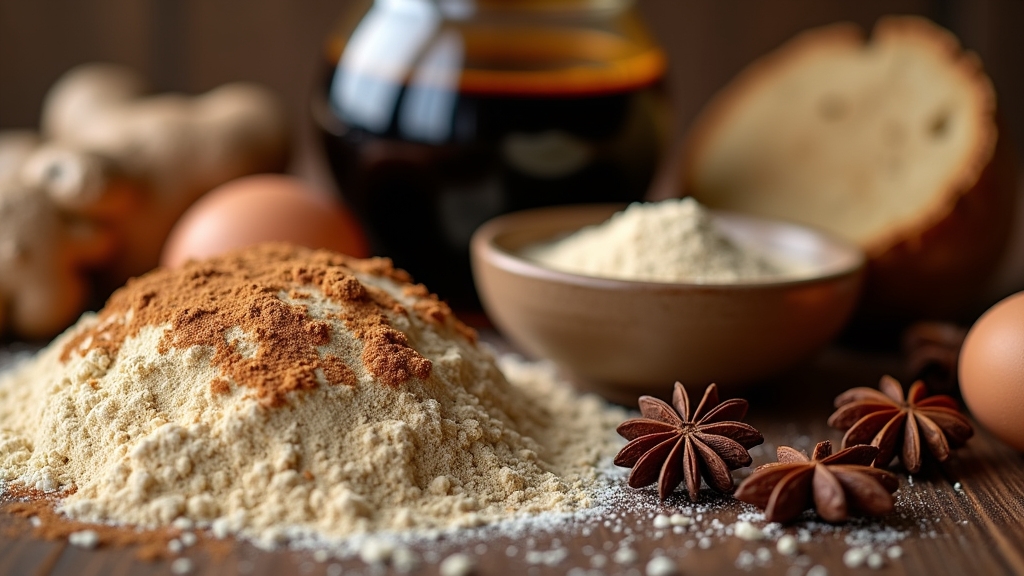
When you gather ingredients for gingerbread sourdough bread, you’ll want to prioritize those that build its signature warm, rich flavor and sturdy texture.
Start with light or mild molasses—this is your flavor anchor, providing that deep gingerbread essence without the harshness of blackstrap. Combine it with brown sugar or honey for caramel notes and moisture. Using high-quality flours enhances the bread’s texture and flavor depth.
Begin with light molasses for rich gingerbread flavor, softened by brown sugar or honey’s sweet moisture.
Use chiefly bread flour for strength and a beautiful crumb, sometimes blending all-purpose flour for balance.
Don’t forget the spices: ground ginger and cinnamon (1-2 teaspoons each), plus a pinch of cloves and nutmeg to deepen the aroma. Salt (about 1.5 to 2 teaspoons) balances flavor and controls fermentation.
Warm water hydrates flour and dissolves sweeteners gently. The fermentation process can lower the glycemic index, making your bread more suitable for health-conscious diets.
Finish with butter or oil for richness, and optionally sour cream or eggs for extra moisture and tenderness. The inclusion of sourdough starter or discard, activated by baking powder and baking soda, helps the bread to rise and adds subtle complexity to the flavor profile, even without long fermentation (leaveners and sourdough discard).
Choosing and Preparing Your Sourdough Starter
Although selecting the right flour might seem straightforward, choosing and preparing your sourdough starter demands careful attention to flour types, water quality, and feeding routines. These factors are essential to cultivate a robust, active culture that will give your gingerbread sourdough bread its distinctive rise and flavor. Using a precise digital scale can help ensure the correct ingredient proportions for a consistent starter.
Opt for a blend of whole wheat and all-purpose flour to balance fermentation speed and mildness. This combination helps create a starter that is both vigorous and well-rounded in taste.
Use filtered water at 70-75°F, avoiding chlorine, to nurture yeast growth effectively. Chlorine can inhibit the natural fermentation process, so clean, temperature-controlled water is crucial.
Feed your starter every 12-24 hours, maintaining consistent ratios and discards to prevent acidity buildup. Regular feeding keeps the culture healthy and active. Remember that the feeding process is vital for maintaining the starter’s vitality and ensuring continuous fermentation.
Store your starter in a warm, draft-free spot with access to oxygen. A wide-mouth jar with a breathable cover works best for this purpose.
| Aspect | Recommendation |
|---|---|
| Flour | Whole wheat + all-purpose blend |
| Water | Filtered, 70-75°F, chlorine-free |
| Feeding Frequency | Every 12-24 hours |
| Container | Wide-mouth jar, breathable cover |
| Storage Environment | Warm, draft-free (70-75°F) |
Combining Spices and Sweeteners for Optimal Flavor
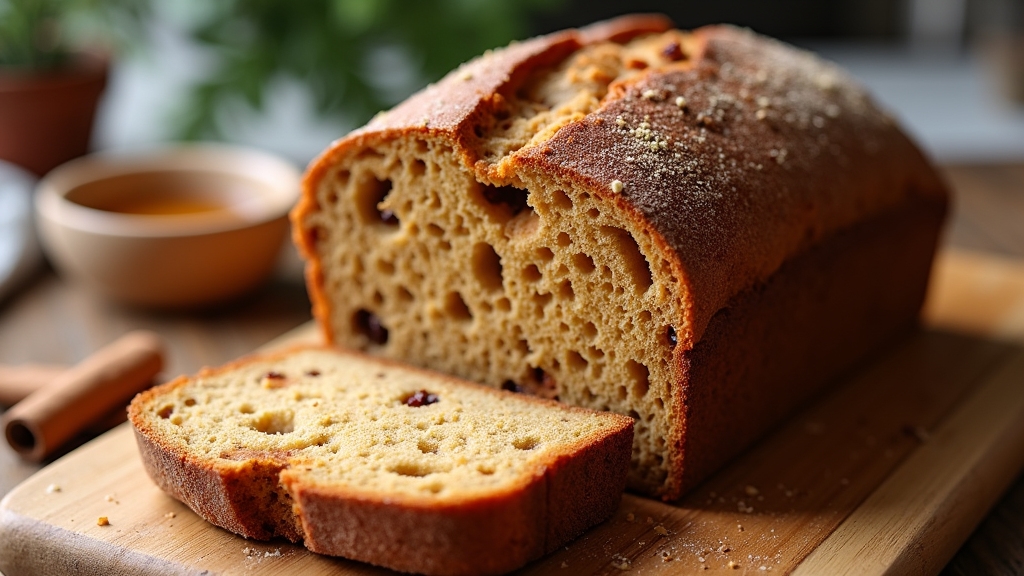
You’ll want to strike the perfect balance between warm spices like ginger, cinnamon, cloves, and nutmeg to build that classic gingerbread depth without overpowering your sourdough’s natural tang.
Selecting sweeteners such as light molasses paired with brown sugar enhances caramel richness and tenderizes the crumb, creating layers of flavor.
Mastering this harmony guarantees every bite delivers a complex, inviting warmth that complements the bread’s texture and rise.
Using sourdough discard not only adds a subtle tang but also allows creative use of leftover starter, making this loaf both delicious and resourceful.
Balancing Warm Spices
Since warm spices like ginger, cinnamon, cloves, and nutmeg form the heart of gingerbread sourdough’s flavor, balancing them with sweeteners is vital to achieving depth and harmony.
You’ll want to mix spices evenly, often premixing with sweeteners like molasses or brown sugar to enhance infusion during fermentation.
Timing salt addition is essential—it brightens spice aroma without overshadowing sweetness. Using a active, bubbly sourdough starter ensures the fermentation process develops these flavors optimally.
Fermentation’s acidity interacts with spices, mellowing sharpness while amplifying complexity.
| Spice | Role in Flavor Balance |
|---|---|
| Ginger | Sharp warmth, dominant note |
| Cinnamon | Sweet warmth, layered addition |
| Cloves | Depth, slight bitterness |
| Nutmeg | Complexity, used sparingly |
Mastering this balance guarantees your bread’s spicy-sweet profile remains vibrant yet nuanced through every bite.
Choosing Complementary Sweeteners
Mastering the interplay between spices and sweeteners unlocks the full potential of your gingerbread sourdough bread. Begin with molasses, the cornerstone that imparts deep, smoky richness and moisture—opt for lighter varieties to avoid bitterness.
Layer in brown sugar, especially dark, to amplify caramel and butterscotch nuances that soften the spice sharpness. Granulated sugar adds clean sweetness and balances texture without overwhelming flavor.
Consider a touch of yogurt or sour cream for subtle tang and moisture, harmonizing with spices like ginger, cinnamon, and cloves.
Adjust sweetener ratios carefully; molasses (~¼ to ½ cup) and brown sugar (¼ to 1 cup) influence crumb and fermentation.
Dissolving molasses in warm liquid ensures even distribution and flavor melding.
Incorporating buttermilk or cultured dairy products can further enhance moisture and depth of flavor in the dough.
Mixing and Fermentation Process Explained
You’ll start by carefully combining wet and dry ingredients to guarantee even hydration and spice distribution. This sets the stage for a vibrant gingerbread flavor.
Timing your fermentation precisely at a steady 78-80ºF allows the dough to develop ideal gluten strength. It also brings out complex sourdough notes.
Mastering these steps is key to achieving the perfect balance of texture. You’ll also get a rich, layered taste that defines great gingerbread.
Using a digital scale ensures accuracy in ingredient measurements, which is crucial for consistent sourdough results.
Wet and Dry Ingredients
Although the balance of wet and dry ingredients might seem straightforward, it profoundly shapes the texture, flavor, and rise of your gingerbread sourdough bread.
You start by combining wet components—active starter, molasses, honey, water or milk, eggs, and fats—which hydrate and enrich the dough. Since sourdough relies on naturally occurring wild yeast rather than commercial yeast, ensuring an active starter is essential for effective leavening and flavor development. Using an active sourdough starter with visible bubbles ensures the best fermentation results.
The dry mix includes bread flour, ginger and warming spices, brown sugar, salt, and sometimes leavening agents to complement sourdough activity.
Key points to master:
- Use a bubbly starter for ideal rise
- Autolyse flour and water to develop gluten before adding salt and starter
- Balance molasses and honey to feed yeast without inhibiting fermentation
- Mix gently, employing stretch and folds for structure
- Control ingredient temperatures to maximize enzymatic action, which is crucial for dough development and fermentation.
This harmony ensures your bread’s moist crumb, spice depth, and perfect lift. Additionally, longer fermentation times foster complex flavor and improve digestibility, enhancing the bread’s overall quality.
Fermentation Timing Tips
Balancing your wet and dry ingredients sets the stage, but the true magic unfolds during fermentation and mixing.
Start by mixing most ingredients, excluding salt and some water, then let the dough rest for 30 minutes (autolyse) to strengthen gluten enzymatically. Incorporating butter and spices into the dough until smooth and elastic ensures even flavor distribution and dough consistency. Maintaining an optimal dough temperature of 74 to 78ºF during this phase supports yeast and bacterial activity for better fermentation.
After autolyse, add salt and reserved water carefully to avoid toughening.
Bulk fermentation thrives best between 78-80ºF, lasting 1.5 to 3 hours at room temperature or 12 to 20 hours refrigerated for deeper flavor and easier handling. Note that fermentation slows with cinnamon and enriched dough with spices may require longer bulk fermentation time. Performing gentle stretch and folds every 30 minutes helps distribute gas and strengthen the dough structure.
Use gentle stretch and folds every 30 minutes to develop gluten without damaging the dough—wet your hands to prevent tearing sticky dough.
Monitor proofing closely; stop when dough is puffy and springs back slowly to the poke.
Mastering timing here releases complex gingerbread flavors and ideal crumb texture.
Techniques for Shaping and Proofing the Dough
When shaping and proofing sourdough gingerbread dough, handling it with care is essential to preserve the delicate gas bubbles that give your loaf its light texture and rich crumb.
Start by gently turning the dough onto a lightly floured surface, avoiding aggressive pressing. Pre-shape it loosely to build cohesion, then perform a tight final shaping to create surface tension for oven spring. Flour the surface before shaping to prevent sticking and help maintain dough integrity.
Proof your dough in a warm spot until it’s puffed and jiggly, or retard proof in the fridge for enhanced flavor and flexibility.
Use bannetons to support the dough’s form during proofing.
Key points to remember:
- Handle dough gently to maintain extensibility
- Use minimal flour only on surfaces
- Create surface tension in final shaping
- Proof at 78-80ºF until bubbly
- Consider retard proofing for flavor depth
Baking Tips for Perfect Crust and Crumb
How do you achieve that perfect balance between a golden, crackling crust and a tender, moist crumb in your gingerbread sourdough?
First, preheat your oven to 350°F (175°C) for even baking and activate your leavening agents properly. Bake for 40-60 minutes, testing doneness with a toothpick—it should come out mostly clean with a few moist crumbs. Using the correct amount of baking soda added with the wet ingredients helps prevent sinking and ensures an even texture.
Preheat to 350°F, bake 40-60 minutes, and test with a toothpick for moist crumb perfection.
Line your loaf pan with parchment paper to guarantee an even crust and easy removal. Avoid overmixing; fold ingredients just until combined and maintain dough hydration thoughtfully to optimize crumb texture.
Use stretch-and-fold techniques during fermentation at 78-80ºF to build gluten without deflating gas bubbles.
Post-baking, cool your loaf fully on a wire rack to prevent gummy crumb.
These steps will give you a crust that’s crisp yet a crumb that’s richly moist and tender.
Variations to Customize Your Gingerbread Bread
Though the classic gingerbread sourdough recipe offers a delightful blend of warm spices and tangy depth, you can easily tailor it to your taste by experimenting with spice blends, sweeteners, and texture enhancers.
Adjust the ginger intensity by using freshly grated ginger or varying ground spices, making sure to also monitor humidity levels during storage to maintain freshness.
Swap molasses for honey or maple syrup to tweak sweetness and depth.
Incorporate whole wheat or rye flour to enrich flavor complexity, and add mix-ins like crystallized ginger or nuts for texture.
Consider brown butter for a nutty richness or fold in sour cream for moistness. The batter’s consistency is very runny, similar to sour cream, which helps achieve a soft, moist texture when baked runny batter.
Try these to customize your loaf:
- Vary ground spices: cinnamon, cloves, cardamom
- Substitute sweeteners: molasses, honey, maple syrup
- Enrich dough: brown butter, sour cream
- Mix flours: whole wheat, rye
- Add texture: crystallized ginger, nuts, dried fruit
Serving Suggestions and Storage Methods
Since gingerbread sourdough bread boasts a rich blend of warm spices and tangy depth, serving it slightly warm or toasted will accentuate its complex flavors and inviting aroma. This type of bread is best enjoyed fresh but can also benefit from proper storage techniques to maintain its quality.
You can enjoy slices plain or spread with butter, cream cheese frosting, or lightly sweetened whipped cream to add richness. Pair it with fresh raspberries or vanilla ice cream for a festive dessert. The blend of spices like ginger, cinnamon, cloves, and nutmeg draws inspiration from traditional gingerbread baking, adding a comforting holiday essence.
For storage, cool the bread completely on a wire rack before wrapping tightly in plastic wrap or storing in an airtight container. Keep it at room temperature for up to two days or refrigerate to extend freshness. Freeze tightly wrapped for long-term storage, thawing before reheating lightly to revive softness. Always avoid moisture buildup and slice just before serving to preserve texture and flavor.
Frequently Asked Questions
Can I Make Gingerbread Sourdough Bread Without Molasses?
Yes, you can make gingerbread sourdough bread without molasses, but you’ll want to adjust carefully. Substitute with golden syrup or honey to keep moisture and sweetness, and add extra liquid to maintain dough hydration.
Expect a milder flavor and lighter color, so consider boosting your spices to preserve that warm depth. Also, watch fermentation closely, as different sugars affect yeast activity and browning during baking.
How Long Can Gingerbread Sourdough Bread Be Frozen?
You can freeze gingerbread sourdough bread for up to 3 months without sacrificing much quality. Make sure to slice it first and wrap each piece tightly in plastic wrap, then double-wrap with foil or place it in a heavy-duty freezer bag to prevent freezer burn.
Label the package with the freezing date so you don’t lose track. After 3 months, texture and flavor will start to decline, so try to use it within that timeframe.
Is It Possible to Use Gluten-Free Flour in This Recipe?
Yes, you can use gluten-free flour, but you’ll need to adjust the recipe carefully. Gluten-free flours lack the structure gluten provides, so you’ll want to combine a multi-purpose gluten-free blend with starches like cornstarch and add binders like xanthan gum or psyllium husk.
Also, using a gluten-free sourdough starter or discard is essential. Expect longer proofing times and tweaks in hydration to get the best texture and rise.
What Is the Best Way to Reheat Leftover Gingerbread Sourdough Bread?
The best way to reheat your leftover gingerbread sourdough bread is to preheat your oven to 350°F.
Lightly spritz the bread with water to keep it moist, then wrap it in foil.
Heat for 10-15 minutes until the crust crisps and the interior is warm.
Avoid microwaving, as it toughens the texture.
This method preserves the rich flavors and moist crumb you love in your gingerbread sourdough.
Can I Add Nuts or Dried Fruits to the Dough?
Yes, you can definitely add nuts and dried fruits to your dough! Just soak dried fruits first to keep them moist and intensify flavor.
Fold in chopped nuts and fruits gently during the final mixing to avoid crushing them. Adjust hydration slightly since these additions add weight and density.
Toasting nuts beforehand boosts their aroma and crunch. This combination will enrich your bread’s texture, flavor complexity, and create a beautifully balanced, aromatic loaf.
Holiday Magic in Every Bite— Bake, Slice, Enjoy
Baking gingerbread sourdough bread is like crafting a warm, fragrant symphony—each spice and starter note blending to create a harmonious loaf. By carefully nurturing your sourdough starter and balancing spices with sweeteners, you’ll achieve a perfect crust and tender crumb that sings with flavor.
Embrace the process with patience and passion, knowing every step adds depth. This bread isn’t just food; it’s an experience you’ll want to share and savor again and again.

